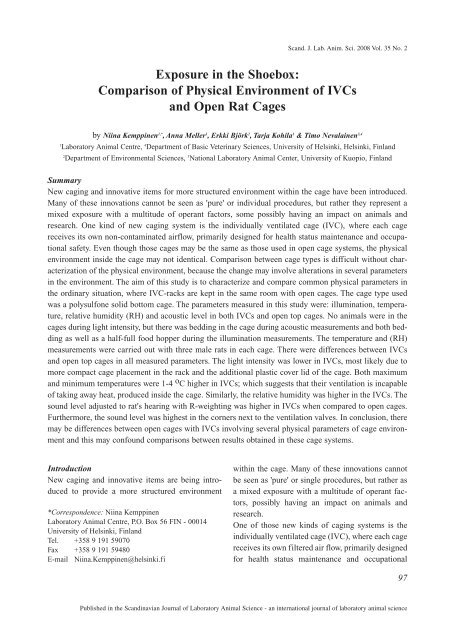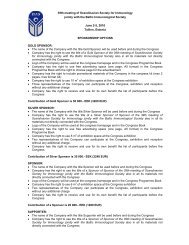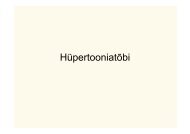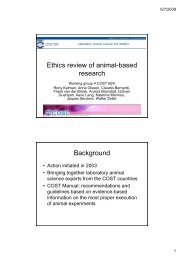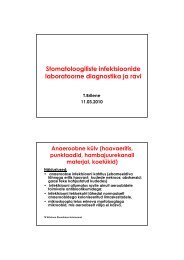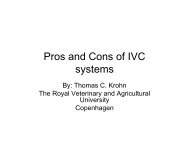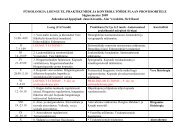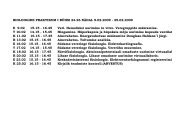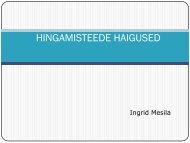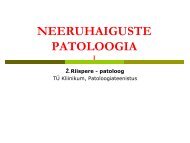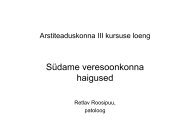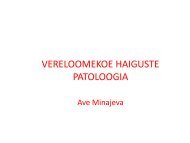Exposure in the Shoebox
Exposure in the Shoebox
Exposure in the Shoebox
Create successful ePaper yourself
Turn your PDF publications into a flip-book with our unique Google optimized e-Paper software.
Introduction<br />
New cag<strong>in</strong>g and <strong>in</strong>novative items are be<strong>in</strong>g <strong>in</strong>troduced<br />
to provide a more structured environment<br />
Scand. J. Lab. Anim. Sci. 2008 Vol. 35 No. 2<br />
<strong>Exposure</strong> <strong>in</strong> <strong>the</strong> <strong>Shoebox</strong>:<br />
Comparison of Physical Environment of IVCs<br />
and Open Rat Cages<br />
by Ni<strong>in</strong>a Kempp<strong>in</strong>en 1,* , Anna Meller 1 , Erkki Björk 2 , Tarja Kohila 1 & Timo Nevala<strong>in</strong>en 3,4<br />
1 4 Laboratory Animal Centre, Department of Basic Veter<strong>in</strong>ary Sciences, University of Hels<strong>in</strong>ki, Hels<strong>in</strong>ki, F<strong>in</strong>land<br />
2 3 Department of Environmental Sciences, National Laboratory Animal Center, University of Kuopio, F<strong>in</strong>land<br />
Summary<br />
New cag<strong>in</strong>g and <strong>in</strong>novative items for more structured environment with<strong>in</strong> <strong>the</strong> cage have been <strong>in</strong>troduced.<br />
Many of <strong>the</strong>se <strong>in</strong>novations cannot be seen as 'pure' or <strong>in</strong>dividual procedures, but ra<strong>the</strong>r <strong>the</strong>y represent a<br />
mixed exposure with a multitude of operant factors, some possibly hav<strong>in</strong>g an impact on animals and<br />
research. One k<strong>in</strong>d of new cag<strong>in</strong>g system is <strong>the</strong> <strong>in</strong>dividually ventilated cage (IVC), where each cage<br />
receives its own non-contam<strong>in</strong>ated airflow, primarily designed for health status ma<strong>in</strong>tenance and occupational<br />
safety. Even though those cages may be <strong>the</strong> same as those used <strong>in</strong> open cage systems, <strong>the</strong> physical<br />
environment <strong>in</strong>side <strong>the</strong> cage may not identical. Comparison between cage types is difficult without characterization<br />
of <strong>the</strong> physical environment, because <strong>the</strong> change may <strong>in</strong>volve alterations <strong>in</strong> several parameters<br />
<strong>in</strong> <strong>the</strong> environment. The aim of this study is to characterize and compare common physical parameters <strong>in</strong><br />
<strong>the</strong> ord<strong>in</strong>ary situation, where IVC-racks are kept <strong>in</strong> <strong>the</strong> same room with open cages. The cage type used<br />
was a polysulfone solid bottom cage. The parameters measured <strong>in</strong> this study were: illum<strong>in</strong>ation, temperature,<br />
relative humidity (RH) and acoustic level <strong>in</strong> both IVCs and open top cages. No animals were <strong>in</strong> <strong>the</strong><br />
cages dur<strong>in</strong>g light <strong>in</strong>tensity, but <strong>the</strong>re was bedd<strong>in</strong>g <strong>in</strong> <strong>the</strong> cage dur<strong>in</strong>g acoustic measurements and both bedd<strong>in</strong>g<br />
as well as a half-full food hopper dur<strong>in</strong>g <strong>the</strong> illum<strong>in</strong>ation measurements. The temperature and (RH)<br />
measurements were carried out with three male rats <strong>in</strong> each cage. There were differences between IVCs<br />
and open top cages <strong>in</strong> all measured parameters. The light <strong>in</strong>tensity was lower <strong>in</strong> IVCs, most likely due to<br />
more compact cage placement <strong>in</strong> <strong>the</strong> rack and <strong>the</strong> additional plastic cover lid of <strong>the</strong> cage. Both maximum<br />
and m<strong>in</strong>imum temperatures were 1-4 o C higher <strong>in</strong> IVCs; which suggests that <strong>the</strong>ir ventilation is <strong>in</strong>capable<br />
of tak<strong>in</strong>g away heat, produced <strong>in</strong>side <strong>the</strong> cage. Similarly, <strong>the</strong> relative humidity was higher <strong>in</strong> <strong>the</strong> IVCs. The<br />
sound level adjusted to rat's hear<strong>in</strong>g with R-weight<strong>in</strong>g was higher <strong>in</strong> IVCs when compared to open cages.<br />
Fur<strong>the</strong>rmore, <strong>the</strong> sound level was highest <strong>in</strong> <strong>the</strong> corners next to <strong>the</strong> ventilation valves. In conclusion, <strong>the</strong>re<br />
may be differences between open cages with IVCs <strong>in</strong>volv<strong>in</strong>g several physical parameters of cage environment<br />
and this may confound comparisons between results obta<strong>in</strong>ed <strong>in</strong> <strong>the</strong>se cage systems.<br />
*Correspondence: Ni<strong>in</strong>a Kempp<strong>in</strong>en<br />
Laboratory Animal Centre, P.O. Box 56 FIN - 00014<br />
University of Hels<strong>in</strong>ki, F<strong>in</strong>land<br />
Tel. +358 9 191 59070<br />
Fax +358 9 191 59480<br />
E-mail Ni<strong>in</strong>a.Kempp<strong>in</strong>en@hels<strong>in</strong>ki.fi<br />
with<strong>in</strong> <strong>the</strong> cage. Many of <strong>the</strong>se <strong>in</strong>novations cannot<br />
be seen as 'pure' or s<strong>in</strong>gle procedures, but ra<strong>the</strong>r as<br />
a mixed exposure with a multitude of operant factors,<br />
possibly hav<strong>in</strong>g an impact on animals and<br />
research.<br />
One of those new k<strong>in</strong>ds of cag<strong>in</strong>g systems is <strong>the</strong><br />
<strong>in</strong>dividually ventilated cage (IVC), where each cage<br />
receives its own filtered air flow, primarily designed<br />
for health status ma<strong>in</strong>tenance and occupational<br />
Published <strong>in</strong> <strong>the</strong> Scand<strong>in</strong>avian Journal of Laboratory Animal Science - an <strong>in</strong>ternational journal of laboratory animal science<br />
97
Scand. J. Lab. Anim. Sci. 2008 Vol. 35 No. 2<br />
safety. O<strong>the</strong>r potential benefits <strong>in</strong>clude: protection<br />
of small groups of animals aga<strong>in</strong>st <strong>in</strong>fections, protection<br />
of <strong>the</strong> environment from <strong>the</strong> animals and<br />
compensation for poor air change rates <strong>in</strong> <strong>the</strong> room<br />
(Brandstetter et al., 2004). Even though <strong>the</strong> cages<br />
may be <strong>the</strong> same as those used <strong>in</strong> open cage systems,<br />
<strong>the</strong> physical environment <strong>in</strong>side <strong>the</strong> cage may<br />
not be identical.<br />
Reports on IVC-systems <strong>in</strong> <strong>the</strong> scientific journals<br />
can be divided <strong>in</strong>to those concerned with <strong>the</strong> design<br />
and recommendations for (Höglund & Renström et<br />
al., 2001; Renström et al., 2001; Hawk<strong>in</strong>s et al.,<br />
2003; Brandstetter et al., 2005) and characterization<br />
of <strong>the</strong> IVC environment (Krohn et al., 2003;<br />
Clough et al., 1995).<br />
The move from traditional open cages to IVCs is<br />
bound to change <strong>the</strong> physical environment of <strong>the</strong><br />
animals liv<strong>in</strong>g <strong>in</strong>; what we have called, <strong>the</strong> ”shoebox”.<br />
It could be anticipated that at least temperature,<br />
relative humidity (RH), acoustic environment<br />
and light <strong>in</strong>tensity may change <strong>in</strong> this transition.<br />
Traditionally <strong>in</strong> biomedical research, attempts are<br />
made to assess <strong>the</strong> <strong>in</strong>dividual effects of compounds<br />
Figure 1. Layout of <strong>the</strong> animal room.<br />
98<br />
Open top cage racks<br />
Sta<strong>in</strong>less steel table<br />
IVC ventilation unit<br />
IVC rack<br />
Rack for empty cages<br />
Computer cab<strong>in</strong>et<br />
and procedures and, usually, evaluation of many<br />
simultaneous events and <strong>the</strong>ir comb<strong>in</strong>ations are<br />
avoided. The term used here is standardization, and<br />
emphasis is on <strong>the</strong> fact that all o<strong>the</strong>r items are<br />
exactly <strong>the</strong> same between study and control groups.<br />
Comparison of open-top cages and IVCs without<br />
characterization of <strong>the</strong> physical environment may not<br />
reveal a s<strong>in</strong>gle causative feature, because <strong>the</strong> change<br />
<strong>in</strong>evitably <strong>in</strong>volves a mixed exposure. The aim of this<br />
study is to characterize and compare physical parameters<br />
<strong>in</strong> a common situation, where IVC-racks are<br />
housed <strong>in</strong> <strong>the</strong> same room with open cages.<br />
Materials and Methods<br />
Animal room<br />
All <strong>the</strong> cages were kept <strong>in</strong> <strong>the</strong> same room (length x<br />
width x height; 5.5 x 3.5 x 3.0 m) along opposite<br />
walls. The locations of cage racks, room furniture,<br />
fluorescent tubes, air <strong>in</strong>let and outlet are illustrated<br />
<strong>in</strong> Figure 1. The IVC-rack (Figure 2) <strong>in</strong>cluded 20,<br />
while <strong>the</strong> open cages (Figure 3) were <strong>in</strong> two racks,<br />
ten cages each. The height of <strong>the</strong> open cage rack<br />
was 176 cm and that of IVC-rack was 186 cm.<br />
Inlet air diffuser below ceil<strong>in</strong>g<br />
Air outlet above <strong>the</strong> door<br />
Fluorescent tubes, height 244 cm from floor
V<br />
e<br />
n<br />
t<br />
i<br />
l<br />
a<br />
t<br />
i<br />
o<br />
n<br />
u<br />
n<br />
i<br />
t<br />
16.4 26.0 29.2 28.9<br />
8.5 7.2 ° 6.2 8.5<br />
3.8 4.4 4.9<br />
Sound measurements<br />
° Temperature and RH measurements<br />
Illum<strong>in</strong>ation measurements<br />
Figure 2. Frontal view of cage and ventilation unit<br />
location <strong>in</strong> IVC-cage rack with cage-specific illum<strong>in</strong>ation<br />
values (lux) and cages where acoustic, temperature<br />
and humidity measurements were done.<br />
Cage types<br />
The measurements were done from two different<br />
cag<strong>in</strong>g systems: open top cages and <strong>in</strong>dividually<br />
ventilated cages (IVC). Cages made of polysulfone<br />
(Tecniplast, Buguggiate, Italy, type1500U, dimensions<br />
48.0 x 37.5 x 21.0 cm) with a solid bottom<br />
were used. Both cage types had a sta<strong>in</strong>less steel<br />
wire lid, while <strong>in</strong> <strong>the</strong> IVCs <strong>the</strong>re was an additional<br />
polysulfone cover, which conta<strong>in</strong>ed <strong>the</strong> air supply<br />
and <strong>the</strong> exhaust air valves and a passive filter at <strong>the</strong><br />
top of <strong>the</strong> cover. This filter allows gas exchange for<br />
a short period, when <strong>the</strong> cage is not docked to <strong>the</strong><br />
IVC-system.<br />
The IVC-system consisted of a ventilation module,<br />
which had both supply and exhaust units (Slim<br />
L<strong>in</strong>e TM , Tecniplast, Buguggiate, Italy) and <strong>the</strong> <strong>in</strong>dividually<br />
ventilated cage rack (Sealsafe TM ,<br />
Tecniplast, Buguggiate, Italy). The supply unit<br />
delivered HEPA (High Efficiency Particulate Air)<br />
Scand. J. Lab. Anim. Sci. 2008 Vol. 35 No. 2<br />
filtered air <strong>in</strong>to <strong>the</strong> cage, taken from <strong>the</strong> room itself,<br />
separately through each cage’s supply valve, at <strong>the</strong><br />
cage cover end. The exhaust air was taken out from<br />
<strong>the</strong> cages, also at <strong>the</strong> same end, through <strong>the</strong> exhaust<br />
valve and voided back to <strong>the</strong> room through a three<br />
filter set down to HEPA level.<br />
Illum<strong>in</strong>ation<br />
Artificial lights with two fluorescent tubes (light<br />
color warm white) were on from 06.00 to 18.00;<br />
<strong>the</strong>ir location <strong>in</strong> <strong>the</strong> room (106 cm below <strong>the</strong> ceil<strong>in</strong>g)<br />
is illustrated <strong>in</strong> Figure 1. The IVC-rack had a<br />
sta<strong>in</strong>less steel shield on top, and <strong>the</strong> open cages<br />
were covered with black plastic sheet<strong>in</strong>g to prevent<br />
direct light enter<strong>in</strong>g <strong>the</strong> cages. No animals were <strong>in</strong><br />
<strong>the</strong> cages dur<strong>in</strong>g <strong>the</strong> light <strong>in</strong>tensity measurements,<br />
but <strong>the</strong>re was bedd<strong>in</strong>g <strong>in</strong> <strong>the</strong> cage and <strong>the</strong> food hopper<br />
was half full. The illum<strong>in</strong>ometer (Rol<strong>in</strong>e digital<br />
lux meter RO 1332, Rotronic AG, Bassersdorf,<br />
Switzerland) was placed at <strong>the</strong> center of <strong>the</strong> cage<br />
floor on <strong>the</strong> bedd<strong>in</strong>g layer and s<strong>in</strong>gle measurements<br />
were taken from both IVCs (Figure 2) and open<br />
cages (Figure 3).<br />
Acoustic environment<br />
A sound analyzer (Norsonic 121, Norsonic AS,<br />
Lierskogen, Norway.) was used for noise measurement.<br />
The measurement system was calibrated<br />
us<strong>in</strong>g a sound level calibrator (Wärtsilä model<br />
5274, MIP Electronics Oy, Kerava, F<strong>in</strong>land). Four<br />
cages from both cage types were measured four<br />
times, once from each corner. The cages had bedd<strong>in</strong>g,<br />
but no animals were <strong>in</strong>side <strong>the</strong> cages dur<strong>in</strong>g<br />
<strong>the</strong> measurements. Measurements were taken from<br />
cages marked with as shown <strong>in</strong> Figures 2 and 3.<br />
Equal sound pressure levels for one m<strong>in</strong>ute (Leq,<br />
1m<strong>in</strong>) <strong>in</strong> third-octave bands between 31.5 Hz and<br />
20 000 Hz were measured with 1 /2 an <strong>in</strong>ch condenser<br />
microphone (Norsonic 1225, Norsonic AS,<br />
Lierskogen, Norway.). The microphone was placed<br />
about 5 cm from <strong>the</strong> walls and <strong>the</strong> bottom of <strong>the</strong><br />
cage, and directed towards <strong>the</strong> corner of <strong>the</strong> cage.<br />
In <strong>the</strong> weighted equal sound pressure level calculations,<br />
R-weight<strong>in</strong>g and A-weight<strong>in</strong>g were used. The<br />
99
Scand. J. Lab. Anim. Sci. 2008 Vol. 35 No. 2<br />
basis of <strong>the</strong> R-weight<strong>in</strong>g for rat hear<strong>in</strong>g sensitivity<br />
and <strong>the</strong> numerical values are described <strong>in</strong> detail by<br />
Björk et al., (2000) and Voipio (1997). The Aweight<strong>in</strong>g<br />
is commonly used <strong>in</strong> human sound<br />
experiments. The total weighted equal sound pressure<br />
levels were computed summ<strong>in</strong>g <strong>the</strong> weighted<br />
third-octave band levels on <strong>the</strong> energy bases. The<br />
weighted equal sound pressure level <strong>in</strong> each cage<br />
was computed as <strong>the</strong> mean value <strong>in</strong> <strong>the</strong> four corners<br />
on <strong>the</strong> energy bases.<br />
Temperature and RH<br />
Temperature and (RH) measurements were carried<br />
out with animals <strong>in</strong> <strong>the</strong> cages. Fischer344<br />
(F344/NHsd, Harlan, Horst, The Ne<strong>the</strong>rlands) male<br />
rats were used <strong>in</strong> this study. The rats were 40 weeks<br />
old and weighed 380 - 400 g, three animals per<br />
cage. The cage floors were covered with 3.0 l aspen<br />
100<br />
16.5<br />
26.7<br />
46.4º<br />
16.2<br />
28.8<br />
25.1 25.3<br />
Table plate<br />
Sound measurements<br />
° Temperature and RH measurements<br />
Illum<strong>in</strong>ation measurements<br />
91.0 53.8<br />
40.9 27.2<br />
17.5 17.3<br />
14.2 17.6<br />
Figure 3. Frontal view of cages <strong>in</strong> open cage racks with cage-specific illum<strong>in</strong>ation values (lux) and cages<br />
where acoustic, temperature and humidity measurements were done.<br />
chip bedd<strong>in</strong>g (size 4 x 4 x 1 mm, 4HP, Tapvei Oy,<br />
Kaavi, F<strong>in</strong>land).<br />
Municipal tap water was provided <strong>in</strong> polycarbonate<br />
bottles with sta<strong>in</strong>less steel dr<strong>in</strong>k<strong>in</strong>g nipples,<br />
changed once a week and refilled once <strong>in</strong> between.<br />
Irradiated pelleted (25 kGy) feed (2016 Global<br />
Rodent Ma<strong>in</strong>tenance, Teklad, Bicester, UK) was<br />
given ad libitum, added once a week.<br />
Temperature and RH were measured with Besser®<br />
7009032 Wireless Wea<strong>the</strong>r Station and with two<br />
Techno l<strong>in</strong>e TX4 433 MHz sensors (Besser, Borken,<br />
Germany). Measurements were taken simultaneously<br />
from both cage types (IVC and open top) and<br />
from <strong>the</strong> room for 7 days. The sensors were placed<br />
<strong>in</strong>side <strong>the</strong> feed hopper next to <strong>the</strong> pellets. Read<strong>in</strong>gs<br />
were taken once a day to provide m<strong>in</strong>imum and<br />
maximum values over <strong>the</strong> previous 24 h period for
Temperature o C<br />
Relative humidity %<br />
4<br />
3<br />
2<br />
1<br />
0<br />
-1<br />
8<br />
6<br />
4<br />
2<br />
0<br />
-2<br />
-4<br />
1 2 3 4 5 6 7<br />
Day<br />
1 2 3 4 5 6 7<br />
Day<br />
A<br />
C<br />
Room<br />
IVC-m<strong>in</strong><br />
IVC-max<br />
Room<br />
IVC-m<strong>in</strong><br />
IVC-max<br />
temperature and RH. Measurements were taken<br />
from cages as marked <strong>in</strong> Figures 2 and 3.<br />
Results<br />
Illum<strong>in</strong>ation<br />
The light <strong>in</strong>tensity at 1 m above floor <strong>in</strong> <strong>the</strong> open<br />
cages was 16-18 lux compared to 6–9 lux <strong>in</strong> <strong>the</strong><br />
IVC´s, with upper cage rows show<strong>in</strong>g considerably<br />
higher values. The light <strong>in</strong>tensities of IVC-racks<br />
were lower than those measured <strong>in</strong> <strong>the</strong> open cages<br />
at correspond<strong>in</strong>g levels. More detailed, cage specific,<br />
values are shown <strong>in</strong> Figures 2 and 3.<br />
Acoustic environment<br />
The sound level adjusted with R-weight<strong>in</strong>g <strong>in</strong><br />
empty IVC cages was 20-25 dB(R) compared to 12-<br />
18 dB(R) <strong>in</strong> <strong>the</strong> empty open cages, with <strong>the</strong> correspond<strong>in</strong>g<br />
adjusted A-weight<strong>in</strong>g be<strong>in</strong>g 45-47 dB(A)<br />
and 46-49 dB(A), respectively. The sound level was<br />
less <strong>in</strong> <strong>the</strong> open cages <strong>in</strong> <strong>the</strong> lower shelves of <strong>the</strong><br />
Temperature o C<br />
Relative humidity %<br />
4<br />
3<br />
2<br />
1<br />
0<br />
-1<br />
8<br />
6<br />
4<br />
2<br />
0<br />
-2<br />
-4<br />
Scand. J. Lab. Anim. Sci. 2008 Vol. 35 No. 2<br />
1 2 3 4 5 6 7<br />
Day<br />
1 2 3 4 5 6 7<br />
Day<br />
B<br />
D<br />
Room<br />
Open-m<strong>in</strong><br />
Open-max<br />
Room<br />
Open-m<strong>in</strong><br />
Open-max<br />
Figure 4. Deviation <strong>in</strong> <strong>the</strong> 24 hourly s<strong>in</strong>gle cage maximum and m<strong>in</strong>imum values <strong>in</strong>side <strong>the</strong> cage for temperature<br />
and relative humidity from <strong>the</strong> correspond<strong>in</strong>g room values dur<strong>in</strong>g <strong>the</strong> week and between cage changes.<br />
A and C are values for IVC-cages and B and D for open cages. Cage changes are marked with an arrow.<br />
rack, while <strong>in</strong> <strong>the</strong> IVCs <strong>the</strong> front of <strong>the</strong> cages<br />
showed higher sound levels compared to <strong>the</strong> back<br />
corners <strong>in</strong> <strong>the</strong> vic<strong>in</strong>ity of <strong>the</strong> air valves. The sound<br />
frequency <strong>in</strong> both cage types was 16 – 16000 Hz.<br />
The mean sound pressure levels <strong>in</strong> <strong>the</strong> third-octave<br />
bands between 31.5 Hz and 20000 Hz on <strong>the</strong> energy<br />
bases of both cage types with R- and A-weight<strong>in</strong>g<br />
and un-weighted (l<strong>in</strong>) are shown <strong>in</strong> Figures 5a<br />
and 5b.<br />
Temperature and RH<br />
There was a marked difference <strong>in</strong> temperature and<br />
RH between <strong>in</strong>side <strong>the</strong> IVC’s and open top cages<br />
when compared to both open top cage and room<br />
values. In <strong>the</strong> IVCs, <strong>the</strong> maximum and m<strong>in</strong>imum<br />
temperature values <strong>in</strong> <strong>the</strong> IVCs were 1-4 °C higher<br />
than <strong>the</strong> room temperature. In <strong>the</strong> open top cages<br />
<strong>the</strong> temperatures were at <strong>the</strong> same level as <strong>the</strong> room<br />
temperatures. There was a similar tendency noted <strong>in</strong><br />
RH as shown <strong>in</strong> Figure 4.<br />
101
Scand. J. Lab. Anim. Sci. 2008 Vol. 35 No. 2<br />
Figure 5 a. Sound spectra <strong>in</strong> open cages.<br />
Figure 5 b. Sound spectra <strong>in</strong> IVC cages.<br />
Discussion<br />
IVCs are a new isolation system be<strong>in</strong>g <strong>in</strong>stalled <strong>in</strong> a<br />
large number of laboratory animal facilities. The<br />
system provides protection to <strong>the</strong> animals aga<strong>in</strong>st<br />
<strong>in</strong>fections, and has clear occupational benefits to<br />
personnel, especially <strong>in</strong> lead<strong>in</strong>g to a reduction <strong>in</strong> <strong>the</strong><br />
levels of airborne allergens (Renström et al., 2001).<br />
It is often assumed that <strong>the</strong> physical environment is<br />
<strong>the</strong> same <strong>in</strong> open cages and IVCs, when <strong>the</strong>y are<br />
kept <strong>in</strong> <strong>the</strong> same room. Surpris<strong>in</strong>gly it was found<br />
that this is not <strong>the</strong> case, and fur<strong>the</strong>rmore that <strong>the</strong><br />
magnitude of <strong>the</strong> changes <strong>in</strong> physical environment<br />
is great enough that it could have an impact on <strong>the</strong><br />
animals housed <strong>in</strong> <strong>the</strong>se cages. Therefore it was<br />
decided to assess a set of easily measurable physical<br />
parameters <strong>in</strong> both cag<strong>in</strong>g systems.<br />
The light <strong>in</strong>tensity <strong>in</strong> IVCs was 10-60 lux lower<br />
than <strong>the</strong> correspond<strong>in</strong>g values <strong>in</strong> open top cages. In<br />
<strong>the</strong> IVCs, <strong>the</strong> illum<strong>in</strong>ation varied between 3.8-28.9<br />
lux and <strong>in</strong> <strong>the</strong> open top cages between 14.2-91.0<br />
lux. The brightest cages were on <strong>the</strong> top row of both<br />
racks and <strong>the</strong> dimmest cages on <strong>the</strong> bottom row.<br />
102<br />
Clough et al., (1995) has shown similar results <strong>in</strong><br />
<strong>the</strong> transparent, polycarbonate positive <strong>in</strong>dividually<br />
ventilated (PIV)-cages but <strong>in</strong> <strong>the</strong> translucent,<br />
polypropylene control cages <strong>the</strong> illum<strong>in</strong>ation was<br />
much brighter than used <strong>in</strong> our experiment. This<br />
difference <strong>in</strong> results may be due to <strong>the</strong> black plastic<br />
sheet<strong>in</strong>g that was placed on top of <strong>the</strong> open top cage<br />
racks to equalize <strong>the</strong> light<strong>in</strong>g <strong>in</strong> both cage types. It<br />
appears that <strong>in</strong> some open top cages at <strong>the</strong> highest<br />
level, <strong>in</strong> contrast to <strong>the</strong> situation <strong>in</strong> <strong>the</strong> IVCs, <strong>the</strong><br />
light<strong>in</strong>g was too bright, and even exceeded values<br />
shown to cause ret<strong>in</strong>al damage <strong>in</strong> alb<strong>in</strong>o rats<br />
(Stotzer et al., 1970; Weisse et al., 1974).<br />
Sound spectra (Figures 5a and 5b) show decreas<strong>in</strong>g<br />
sound levels when approach<strong>in</strong>g 16000 Hz and consequently<br />
it can be assumed that no ultrasound<br />
exists <strong>in</strong> ei<strong>the</strong>r cage type. Accord<strong>in</strong>gly <strong>the</strong> measured<br />
R-weighted sound pressure levels depict <strong>the</strong> correct<br />
sound level which would be heard by <strong>the</strong> rats. In<br />
IVCs, <strong>the</strong> R-weighted sound levels were about 7<br />
dB(R) higher than <strong>in</strong> open top cages; energywise<br />
<strong>the</strong> difference was five fold and <strong>in</strong> terms of loudness<br />
almost twice as great. Although <strong>the</strong> difference<br />
<strong>in</strong> sound levels audible to <strong>the</strong> rat (R-weighted) is<br />
large, it rema<strong>in</strong>s to be determ<strong>in</strong>ed whe<strong>the</strong>r <strong>the</strong> levels<br />
measured (< 25 dB(R)) have any major impact<br />
on <strong>the</strong> animals.<br />
Scheer et al., state <strong>the</strong> obvious: The climatic conditions<br />
<strong>in</strong> <strong>the</strong> cage are dependent on those of <strong>the</strong> surround<strong>in</strong>g<br />
room as well as <strong>the</strong> air supply of <strong>the</strong> cagerack.<br />
In this study <strong>the</strong> temperature and RH <strong>in</strong> IVCs<br />
were <strong>the</strong> same as <strong>in</strong> <strong>the</strong> animal room when measured<br />
without animals, but placement of animals <strong>in</strong>to<br />
<strong>the</strong> IVCs <strong>in</strong>creased <strong>the</strong> temperature by 3-4 °C and<br />
RH by about 6 % <strong>in</strong> <strong>the</strong>se cages.<br />
In <strong>the</strong> open top cages, <strong>the</strong> temperature and RH were<br />
at <strong>the</strong> same level as <strong>in</strong> <strong>the</strong> animal room. This is <strong>in</strong><br />
agreement with <strong>the</strong> results of Clough et al. (1995)<br />
who have shown similar results <strong>in</strong> PIV-cages. It<br />
appears that IVC-ventilation is unable to remove all<br />
<strong>the</strong> heat produced <strong>in</strong> <strong>the</strong> cage. Potential sources are<br />
heat from <strong>the</strong> animals as well as heat generated<br />
from ur<strong>in</strong>e-feces-bedd<strong>in</strong>g fermentation. Heat emission<br />
for three animals <strong>in</strong> a cage is estimated to be
about 12 W (He<strong>in</strong>e, 1998). However, fermentation<br />
reactions are unlikely to occur because ventilation<br />
tends to keep bedd<strong>in</strong>g too dry.<br />
It appears that <strong>the</strong> transition from traditional open<br />
top cages to IVCs may lead to changes <strong>in</strong> <strong>the</strong> physical<br />
environment. This makes any comparisons of<br />
<strong>the</strong>se cag<strong>in</strong>g systems problematic without characterization<br />
of <strong>the</strong> physical parameters e.g. light<strong>in</strong>g <strong>in</strong>tensity,<br />
sounds, temperature and RH. In conclusion,<br />
comparison of open cages with IVCs <strong>in</strong>volves several<br />
physical parameters <strong>in</strong> <strong>the</strong> cage environment,<br />
which may confound straightforward comparisons.<br />
Acknowledgements<br />
This study has received f<strong>in</strong>ancial support from <strong>the</strong><br />
F<strong>in</strong>nish M<strong>in</strong>istry of Education, <strong>the</strong> Academy of<br />
F<strong>in</strong>land, <strong>the</strong> ECLAM and ESLAV Foundation, <strong>the</strong><br />
North-Savo Cultural Foundation, <strong>the</strong> F<strong>in</strong>nish<br />
Research School for Animal Welfare, <strong>the</strong> Oskar<br />
Öflund Foundation and <strong>the</strong> University of Kuopio.<br />
References<br />
Björk E, T Nevala<strong>in</strong>en, M Hakumäki M & HM<br />
Voipio. R-weight<strong>in</strong>g provides better estimation<br />
for rat hear<strong>in</strong>g sensitivity. Lab Anim, 2000, 34,<br />
136-144.<br />
Brandstetter H, M Scheer, C He<strong>in</strong>ekamp, C<br />
Gippner-Stepper, O Loge, L Ruprecht, B Thull,<br />
R Wagner, P Wilhem & HP Scheuber.<br />
Performance evaluation of IVC system. Lab<br />
Anim, 2005, 39, 40-44.<br />
Clough G., J Wallace, MR Gamble, ER<br />
Merrywea<strong>the</strong>r & E Bailey. A positive, <strong>in</strong>dividually<br />
ventilated cag<strong>in</strong>g system: a local barrier<br />
system to protect both animals and personnel.<br />
Scand. J. Lab. Anim. Sci. 2008 Vol. 35 No. 2<br />
Lab Anim, 1995, 29, 139-151.<br />
Hawk<strong>in</strong>s P, D Anderson, K Applebee, D Key, J<br />
Wallace, G Milite, J MacArthur Clark, R<br />
Hubrecht & M Jenn<strong>in</strong>gs. Individually ventilated<br />
cages and rodent welfare: Report of <strong>the</strong> 2002<br />
RSPCA/UFAW rodent welfare group meet<strong>in</strong>g.<br />
Anim Technol Welf, 2003, 2, 23-34.<br />
He<strong>in</strong>e WOP. Environmental management <strong>in</strong> laboratory<br />
animal units. Basic Technology and<br />
Hygiene Methods and Practice. Pabst Science<br />
Publishers, Berl<strong>in</strong>, 1998.<br />
Höglund AU & A Renström. Evaluation of <strong>in</strong>dividually<br />
ventilated cage systems for laboratory<br />
rodents: cage environment and animal health<br />
aspects. Lab Anim, 2001, 35, 51-57.<br />
Krohn TC, AK Hansen & N Dragsted. The impact of<br />
cage ventilation on rats housed <strong>in</strong> IVC system.<br />
Lab Anim, 2003, 37, 85-93.<br />
Renström A, G Björ<strong>in</strong>g & U Höglund. Evaluation of<br />
<strong>in</strong>dividually ventilated cage systems for laboratory<br />
rodents: occupational health aspects. Lab<br />
Anim, 2001, 35, 42-50.<br />
Scheer M, C He<strong>in</strong>ekamp, B Thull, R Wagner, & HP<br />
Scheuber. Performance evaluation of IVC systems<br />
- Part 1: Test <strong>in</strong>structions. Available:<br />
www.lal.org.uk/IVC/<strong>in</strong>dex.html<br />
Stotzer H, I Weisse, F Knappen & R Seitz. Die<br />
Ret<strong>in</strong>a-Degeneration der Ratte.<br />
Arzneimittelforschung, 1970, 20, 811-817.<br />
Voipio HM. How do rats react to sound? Scand J<br />
Lab Anim Sci, 1997, 24 (Suppl 1), 1-80.<br />
Weisse I, H Stotzer & R Seitz. Age and light-dependent<br />
changes <strong>in</strong> <strong>the</strong> rat eye. Virchows Arch<br />
Pathol Anat Physiol Kl<strong>in</strong> Med, 1974, 362, 145-<br />
156.<br />
103


